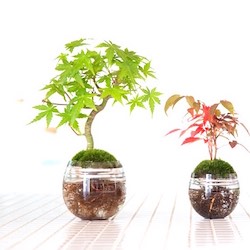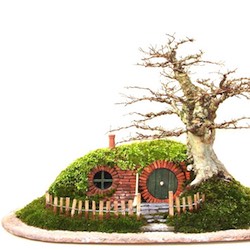This tree looks aggressive and possesses an irreverent beauty, of contorted shapes and delicate foliage, adorned with that endless amount of thorns.
The botanical name for this tree is Ceiba erianthos, it is also known as the paineira das pedras or simply as dragon tree. In this article we investigate the tree species and show a remarkable progression of this tree, by Nacho Marin.

Front of the tree.

Back of the tree.
Specifications about the Ceiba erianthos
Scientific name: ceiba erianthos.
Common name: paineira das pedras (Brazil), ceiba throughout Latin America. Endemic to Brazil and Peru. Malvaceae family, bombácea subfamily.
The tree has compound leaves of 5" (12cm). in diameter. The flowers are white and pink in the center, have a fleshy texture and can become approximately 6" (15cm). in diameter. The branches are covered with thorns, thick and of varied sizes and shapes. The thorns make this tree very special.
Surely they will never cease to be my greatest motivation and inspiration.

A few particularities about the tree
Its thorns do not rot.
Its roots (receptors of water) and tubers (accumulators of water), can be exposed and used as logs or part of the trunk.
The tubers when they become exposed do not have thorns, but they produce them over time and are completely covered with them.
If a thorn is removed or falls by accident, the tree will produce new thorns to replace it.
If the artist needs to make a large extraction cut from any part of the tree, it will be covered and thorns will sprout on its new bark.
It perfectly withstands strict and partial cuts, producing new and abundant sprouts - very useful for designing as bonsai.
It is possible to graft branches in any section of its size.
It reduces its leaf to a third and more of its natural size.
It does not bloom in bonsai state.
Its cultivation is simple, the substrate used by me is pebble or river stone. The required fertilizer can be chemical or organic under normal conditions of generic cultivation. And strangely it is attacked by pests.
It is advisable after establishing the final design, to make periodic checks of the roots to extract new tubers that occupy vital space in the substrate. In addition, its roots tend to create compact blocks that stop the normal development of the tree, creating fungi and putrefaction.
It is possible to cut any amount of tubers and roots required without risking the life of the tree, always leaving food roots to resume its vital process.
Deadwood can not be created on this tree species.
Propagation and advice
Its method of propagation is diverse: By cuttings, not always safe. By layering, always safe. Its tubers do not produce new trees, presumably they do not contain branch buds, only roots. It is possible to graft branches onto the tubers and obtain new trees.
Wiring is performed like any other bonsai, in addition we can use adjustable tensioners. Its branches are very flexible even when they are very thick.

How this tree was created
Its construction began about 9 years ago, when a Venezuelan teacher gave me a small seedling no larger than 7" (18cm). I always place the seedlings inclined in a very small pot, this in order to condition the growth of their tubers from a young age in an unpredictable way due to the deformation caused by their collision against the walls of the container. We will be aware of the achievement of the tubers, by the deformation that they produce in the plastic training cup. That will be the moment to extract the tree from the vase and very carefully select the most interesting tubers for our future trunk. The next step will be to repackage a slightly larger pot to help us repeat the process, over and over again until the artist sees fit to stop the process and accept the trunk that chance gave us.

The construction will be gradual and always thinking that the trunk will be unexpected and interpretive reading as it is discovered over time. In the case of this trunk, it was carried out in 5 steps and its branches were intuitively modeled little by little until level 3 and from then on its exact position was decided.

About the design
The search in the dynamics of movement gave as a resolution the strong movement of the volume try of the foliage to the left as opposed to the natural movement of the trunk to the right, giving the whole character, grace and movement, enriching its wild and aggressive nature. Adjust this set by catching the drama of the thorns and placing them in the glass as a visual counterweight, providing drama and harmony to the set. These changes made to the glass of Chinese origin were made with epoxy materials and acrylic paints.




Nacho Marin runs a Bonsai school in Venezuela, find him on Instagram (nachomarin_art) and Facebook (nacho marin).




